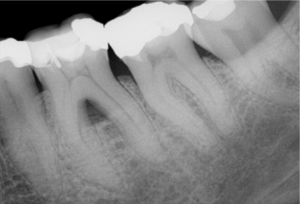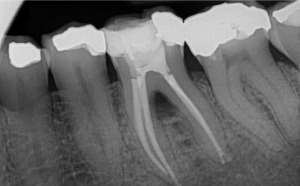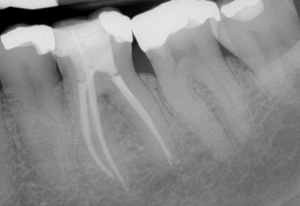A case study by Dr. Chafic Safi, Centre Endodontique St-Laurent
A 60 year-old Caucasian female presented to our office with a chief complaint:
“I have a bump next to my tooth. I have been told the tooth might need to be extracted.”
Analysis
Clinical exam revealed a non- traceable sinus tract around the first lower left molar (tooth #36).
The tooth was heavily restored. The tooth did not respond to any cold, percussion, or palpation. There was a slight buccal probing. Mobility was within normal limits.
Radiological exam revealed deep and extensive restorative work with presence of a radiolucency around the furcation.
The tooth also exhibited heavy chamber and canal calcifications.
Diagnosis
The diagnosis was a necrotic pulp and chronic apical abscess.
- Figure 1: Radiographie pré-opératoire / Pre-operative radiograph
- Figure 2: Radiographie finale / Post-operative radiograph
Treatment
The treatment options offered to the patient were:
- Root canal treatment. Prognosis: Favorable
- Extraction. Prognosis: Favorable
Treatment Selection
The patient opted for saving her tooth via a root canal treatment.
The Treatment
The root canal treatment was completed in 2 visits with placement of an intra-canal medicament, Calcium Hydroxide in this case, in order to enhance microbial control.
There was a 14 day-period in between appointments. At the second appointment, absence of sinus tract was confirmed. No antibiotic was prescribed.
There were 4 canals in the tooth. Each canal was cleaned and shaped using new generation rotary files, The XP-Shaper and XP- Finisher. Irrigation was performed using 3% NaOCl during instrumentation. The final irrigation protocol sequence was: 3% NaOCl- 17% EDTA- 2% Chlorhexidine
Root canal obturation was performed using cold hydraulic condensation with Bioceramic Sealer and Bioceramic Gutta Percha. The access cavity was sealed with resin composite. A final restoration with cuspal coverage was advised.
Follow-up
6-month follow-up showed absence of any signs or symptoms. There was no more buccal probing. The radiograph shows complete healing of the furcation lesion. A final restoration with cuspal coverage was advised again.
More Information
Advantages of XP files:
- Anatomic cleaning
- Safe/no excessive torque
- Conservative
- Efficient and optimal cleaning[/vc_column_text]
Advantages of Bioceramic Sealer:
- Biocompatible
- Hydrophilic
- Binds to dentin
- Bioactive/ induces stem cell differentiation
- Does not shrink
- Does not wash out
Additional Images
- Figure 3: Radiographie du suivi au 6ème mois / 6-month follow-up radiograph


